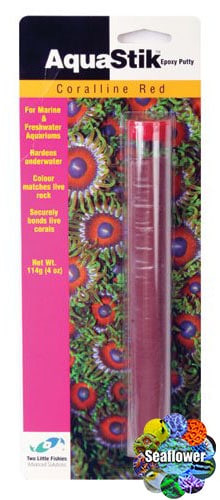Aquastik red (4oz) 114g
€15,00
Aquastik red (4oz) 114g Clay-like aquarium epoxy putty for no-mess application
In stock
Aquastik red (4oz) 114g Clay-like aquarium epoxy putty for no-mess application
Aquastik is a fantastic clay-like aquarium epoxy putty designed for a no-mess application. Here are some of its key features:
- Nontoxic epoxy putty that is great for aquascaping aquariums
- Ideal for coral propagation, securing coral frags to live rock or plugs
When it comes to usage, AquaStik Epoxy Putty from Two Little Fishies is a versatile solution for attaching various aquascaping items. This nontoxic epoxy effectively bonds corals, live rock, gorgonians, plants, and more, either to each other or directly to glass. The unique red color blends beautifully with coralline algae, while the grey color complements live rock perfectly. You can drill, sand, or saw it after it has fully cured.
AquaStik Epoxy Putty adheres to a variety of materials including wood, concrete, ceramic, acrylic, metal, and fiberglass. It mixes in just one minute, hardens in 20 minutes, and fully cures within 24 hours. It is suitable for use in marine and freshwater aquariums, ponds, paludariums, as well as reptile and small animal habitats.
- Peel back the plastic wrapper to twist or cut off the required amount of AquaStik.
- To mix, knead it with your fingers for about one minute until you achieve a uniform color (if you have sensitive skin, gloves are recommended). Press and hold it in place for 2 minutes.
- Apply it to the surface within 2 minutes of mixing. The working time is about 5 minutes, as the mixed epoxy does not exhibit strong bond strength at this stage but will harden after 20 minutes and completely cure in 24 hours.
- Any unmixed portion can be placed back into the tube for later use.
Note: Using large quantities may temporarily cause your protein skimmer to foam excessively. It is advisable to turn off the skimmer for 36 hours after use.
You can enhance structural bonds by using plastic rods. Avoid cutting off any excess epoxy, as this may weaken the attachment. Do not worry, coralline algae will soon cover any exposed epoxy, and corals will also grow over it, forming an additional bond.
When attaching fragmented branches of Acropora and other stony corals, surround the base with epoxy and press it into a hole in the rock. A toothpick or plastic rod inserted into the base or a peg can provide extra support for larger pieces or soft corals.
For Gorgonians, if there is a base, apply epoxy underneath and push the base into a deep depression in the rock, holding it there by hand for 2 minutes. You may use rubber bands, plastic cable ties, monofilament line, or a clamping device to keep larger pieces in place until the epoxy cures. After 24 hours, you can remove the clamp or cut the temporary bands. If the gorgonian does not have a base, clean about 1 inch of live tissue off the woody skeleton from the bottom of the stem. Cover the exposed portion with enough epoxy to hold the specimen firmly when inserted into a hole in the rock. Push the excess epoxy down into the hole and around the stem for extra security. Plastic toothpick shims can be used to help hold particularly large specimens in place.
For freshwater planted aquariums and paludariums, AquaStik can be used to attach various plants such as Java Fern, Java Moss, Bolbitis, Riccia, Anubias species, and others to wood and rocks.
General Information: AquaStik works well on dry, damp, or wet surfaces and can cure underwater. It is nontoxic to fish, invertebrates, aquatic plants, reptiles, and small animals. This product is excellent for attaching live rock, stony corals, gorgonians, aquatic plants, and other aquascaping items. It bonds to wood, concrete, ceramics, acrylic, metals, and fiberglass. AquaStik can be drilled, sanded, sawed, and machined, making it useful for repairs. It is hand kneadable and cures quickly without any strong odor. It mixes in 1 minute and hardens in 20 minutes, achieving full strength in 24 hours. The stick format helps eliminate waste or mis-proportioning, and its clay-like consistency allows for a no-mess application without the need for tools. It is perfect for use in marine and freshwater aquariums, ponds, paludariums, and habitats for reptiles and small animals.
| Weight | 0,2000 kg |
|---|---|
| GTIN | 748172442005 |

